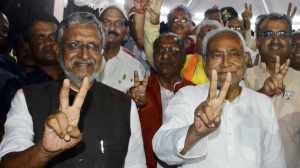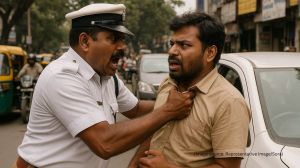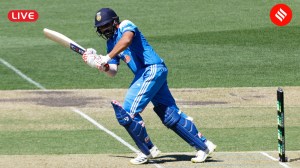The Bhojshala and the Raja
In March 2001, on my way to Mandu, I stopped at Dhar to visit the Bhojshala, the temple-cum-school complex founded by Raja Bhoj in the 11th ...

In March 2001, on my way to Mandu, I stopped at Dhar to visit the Bhojshala, the temple-cum-school complex founded by Raja Bhoj in the 11th century. Although a former MP, I was prevented from entering the building by the Reserve Police. Since I spoke in Urdu to the officer in charge, he told me that I could come back at prayer time any Friday. When I revealed that I was not a Muslim, he regretfully stated that Hindus would have to wait until Basant Panchami to pray there. He explained that he was helpless—he was only enforcing the order issued by the Digvijay Singh government in 1997.
The Department of Archaeology, Gwalior, 1952, has in a special book dealt with the cultural heritage of Madhya Bharat which, in 1956, amalgamated with the Central Provinces and came to be known as Madhya Pradesh. Another book, Dhar and Mandu, published by Bisham Nath Bhargava (Allahabad), reiterates what Major C.E. Luard, the official gazetteer of Dhar, had said in 1912. The carved pillars used all over the building and the delicately carved ceilings of the prayer hall seem to have belonged to the original Bhojshala.
On the pavement of the prayer hall are numerous slabs of black slate stone, the lettering on which were also scraped off. A few slabs recovered from another part of the building and exhibited there, contain the texts of the poetic works of Parijatamanjari and Kurmastotra. It appears then that the old college was adorned with numerous Sanskrit and Maharashtri Prakrit texts, beautifully engraved on such slabs.
In 1935 some local residents of Dhar, which was then a princely state, insisted that the Bhojshala was a Hindu institution — the temple of Goddess Saraswati, on the one hand, and a school, on the other. The idol is still on display in the British Museum at London.
The District Gazetteer says that the Raja Bhoj school is a mosque, a part of which was converted from a Hindu institution. According to the publication, this shrine of Saraswati, the Hindu goddess of learning, is described in the Sanskrit play of Arjunavarma Paramara (1210-16) as the ornament of the 84 squares of Dharanagari. Two slabs were discovered behind the mehrab, one bearing the Prakrit odes of the 11th century (supposed to have been composed by Raja Bhoj himself) and the other, the Sanskrit play cited above.
On the strength of their conviction, the local residents demanded that the Bhojshalaa masjid be reconverted into a mandir. Although the Maharaja of Dhar was a Hindu, he was under the influence of the British resident, who was reported to have advised him to ban public entry into the edifice for a while. The maharaja did as advised, except for allowing Hindus to enter on Basant Panchami day, which is the day of Saraswati puja. Similarly, the Muslims were allowed entry on one day in the year.
This was twisted by the Digvijay Singh government into a discriminatory order mentioned earlier. Such are the wages of secularism in India.



- 01
- 02
- 03
- 04
- 05




























